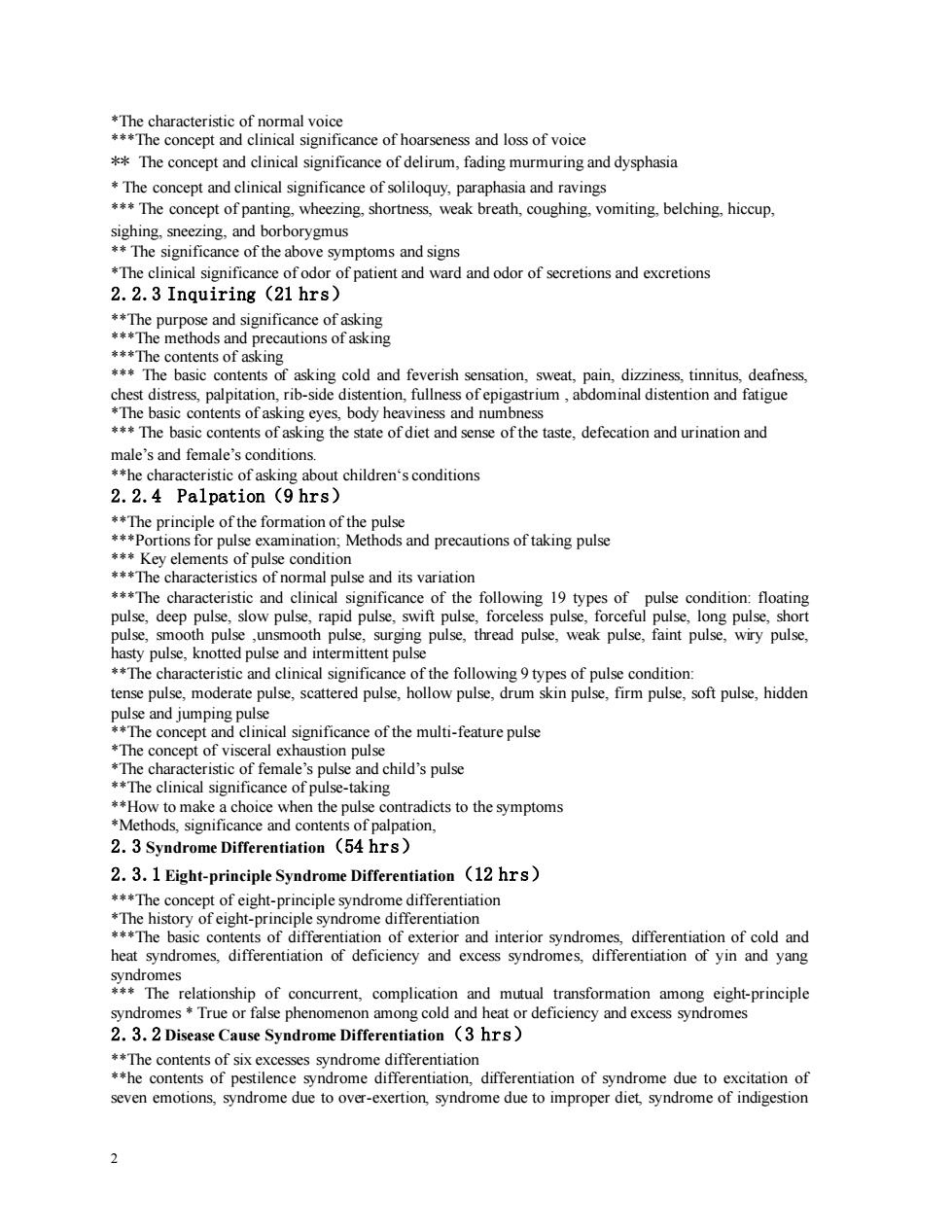正在加载图片...

*The characteristic of normal voice ***The concept and clinical significance of hoarseness and loss of voice *The concept and clinical significance of delirum,fading murmuring and dysphasia The concept and clinical significance of soliloquy,paraphasia and ravings **The concept of panting,wheezing,shortness,weak breath,coughing,vomiting,belching,hiccup, sighing.sneezing,and borborygmus *The significance of the above symptoms and signs *The clinical significance of odor of patient and ward and odor of secretions and excretions 2.2.3 Inquiring (21 hrs) **The purpose and significance of asking ***The methods and precautions of asking ***The contents of asking **The basic contents of asking cold and feverish sensation,sweat,pain,dizziness,tinnitus,deafness, chest distress,palpitation,rib-side distention,fullness of epigastrium,abdominal distention and fatigue *The basic contents of asking eyes,body heaviness and numbness **The basic contents of asking the state of diet and sense of the taste,defecation and urination and male's and female's conditions. **he characteristic of asking about children's conditions 2.2.4 Palpation (9 hrs) **The principle of the formation of the pulse ***Portions for pulse examination;Methods and precautions of taking pulse **Key elements of pulse condition ***The characteristics of normal pulse and its variation ***The characteristic and clinical significance of the following 19 types of pulse condition:floating pulse,deep pulse,slow pulse,rapid pulse,swift pulse,forceless pulse,forceful pulse,long pulse,short pulse,smooth pulse ,unsmooth pulse,surging pulse,thread pulse,weak pulse,faint pulse,wiry pulse, hasty pulse,knotted pulse and intermittent pulse **The characteristic and clinical significance of the following 9 types of pulse condition: tense pulse,moderate pulse,scattered pulse,hollow pulse,drum skin pulse,firm pulse,soft pulse,hidden pulse and jumping pulse **The concept and clinical significance of the multi-feature pulse *The concept of visceral exhaustion pulse *The characteristic of female's pulse and child's pulse **The clinical significance of pulse-taking **How to make a choice when the pulse contradicts to the symptoms *Methods,significance and contents of palpation, 2.3 Syndrome Differentiation (54 hrs) 2.3.1 Eight-principle Syndrome Differentiation (12 hrs) ***The concept of eight-principle syndrome differentiation *The history of eight-principle syndrome differentiation ***The basic contents of differentiation of exterior and interior syndromes,differentiation of cold and heat syndromes,differentiation of deficiency and excess syndromes,differentiation of yin and yang syndromes **The relationship of concurrent,complication and mutual transformation among eight-principle syndromes True or false phenomenon among cold and heat or deficiency and excess syndromes 2.3.2 Disease Cause Syndrome Differentiation (3 hrs) **The contents of six excesses syndrome differentiation **he contents of pestilence syndrome differentiation,differentiation of syndrome due to excitation of seven emotions,syndrome due to over-exertion,syndrome due to improper diet,syndrome of indigestion 22 *The characteristic of normal voice ***The concept and clinical significance of hoarseness and loss of voice ** The concept and clinical significance of delirum, fading murmuring and dysphasia * The concept and clinical significance of soliloquy, paraphasia and ravings *** The concept of panting, wheezing, shortness, weak breath, coughing, vomiting, belching, hiccup, sighing, sneezing, and borborygmus ** The significance of the above symptoms and signs *The clinical significance of odor of patient and ward and odor of secretions and excretions 2.2.3 Inquiring(21 hrs) **The purpose and significance of asking ***The methods and precautions of asking ***The contents of asking *** The basic contents of asking cold and feverish sensation, sweat, pain, dizziness, tinnitus, deafness, chest distress, palpitation, rib-side distention, fullness of epigastrium , abdominal distention and fatigue *The basic contents of asking eyes, body heaviness and numbness *** The basic contents of asking the state of diet and sense of the taste, defecation and urination and male’s and female’s conditions. **he characteristic of asking about children‘s conditions 2.2.4 Palpation(9 hrs) **The principle of the formation of the pulse ***Portions for pulse examination; Methods and precautions of taking pulse *** Key elements of pulse condition ***The characteristics of normal pulse and its variation ***The characteristic and clinical significance of the following 19 types of pulse condition: floating pulse, deep pulse, slow pulse, rapid pulse, swift pulse, forceless pulse, forceful pulse, long pulse, short pulse, smooth pulse ,unsmooth pulse, surging pulse, thread pulse, weak pulse, faint pulse, wiry pulse, hasty pulse, knotted pulse and intermittent pulse **The characteristic and clinical significance of the following 9 types of pulse condition: tense pulse, moderate pulse, scattered pulse, hollow pulse, drum skin pulse, firm pulse, soft pulse, hidden pulse and jumping pulse **The concept and clinical significance of the multi-feature pulse *The concept of visceral exhaustion pulse *The characteristic of female’s pulse and child’s pulse **The clinical significance of pulse-taking **How to make a choice when the pulse contradicts to the symptoms *Methods, significance and contents of palpation, 2.3 Syndrome Differentiation(54 hrs) 2.3.1 Eight-principle Syndrome Differentiation(12 hrs) ***The concept of eight-principle syndrome differentiation *The history of eight-principle syndrome differentiation ***The basic contents of differentiation of exterior and interior syndromes, differentiation of cold and heat syndromes, differentiation of deficiency and excess syndromes, differentiation of yin and yang syndromes *** The relationship of concurrent, complication and mutual transformation among eight-principle syndromes * True or false phenomenon among cold and heat or deficiency and excess syndromes 2.3.2 Disease Cause Syndrome Differentiation(3 hrs) **The contents of six excesses syndrome differentiation **he contents of pestilence syndrome differentiation, differentiation of syndrome due to excitation of seven emotions, syndrome due to over-exertion, syndrome due to improper diet, syndrome of indigestion